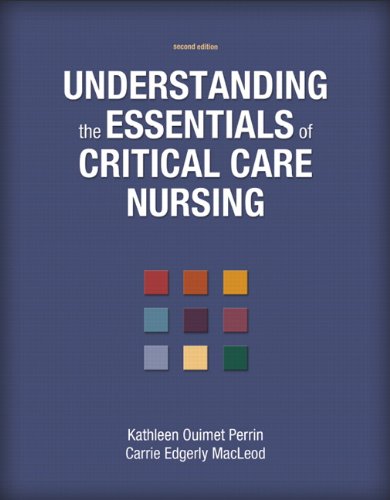Solution Manual for Understanding the Essentials of Critical Care Nursing 2nd Edition by Perrin
$35.00 Original price was: $35.00.$26.50Current price is: $26.50.
Solution Manual for Understanding the Essentials of Critical Care Nursing 2nd Edition by Perrin
This is completed downloadable of Solution Manual for Understanding the Essentials of Critical Care Nursing 2nd Edition by Perrin

Product Details:
- ISBN-10 : 0132724154
- ISBN-13 : 978-0132724159
- Author: Kathleen Ouimet Perrin (Author), Carrie Edgerly MacLeod (Author)
UNDERSTANDING THE ESSENTIALS OF CRITICAL CARE NURSING, 2/e introduces all foundational elements of critical care nursing that are essential to delivering safe, effective care, and provide the basis for the eventual delivery of sophisticated, expert care. It focuses on the techniques and concepts most important for novice critical care nurses to understand, and the care of patients with the most common critical illnesses, establishing the groundwork students need to become increasingly effective and capable of offering increasingly advanced care. Key topics include: nursing assessment of critically ill patients; evidence based practices; safety initiatives; commonly used medications; and leading technologies for providing better care. This edition contains extensive new coverage ranging from 2010 AHA Guidelines to safety and evidence-based practice; and calls greater attention to nursing actions associated with collaborative care.
Table of Content:
Chapter 1 What Is Critical Care?
RESOURCE LIBRARY
COMPANION WEBSITE
Case Study: Critical Care Nursing
Nursing Care Plan
NCLEX Review Questions
Media Links
Media Link Applications
Learning Outcome 1
Define critical care.
Concepts for Lecture
1. Critical care is the direct delivery of medical care to a critically ill or injured patient. The care is often delivered in a specialized unit with advanced technology available. This care is provided by a specially trained team of professionals.
2. Critical care is defined by the Department of Health and Human Services (2001) as the “direct delivery of medical care for a critically ill or injured patient. To be considered critical an illness or injury must acutely impair one or more vital organ systems such that a patient’s survival is jeopardized. Critical care is usually but not always given in a critical care area such as a coronary care unit, an intensive care unit, a respiratory care unit, or an emergency care unit.”
PowerPoint Lecture Slides
1. Critical care—“direct delivery of medical care for a critically ill or injured patient. To be considered critical an illness or injury must acutely impair one or more vital organ systems so that a patient’s survival is jeopardized” (Department of Health and Human Services, 2001).
2. Elements of critical illness or injury:
• Impairment of one or more vital organs
• Patient survival jeopardized
• Care given in specialty unit with specialized personnel and equipment
Suggested Strategies for Classroom Experience
Ask students to share examples of patient conditions that, according to the definition provided, would require critical care.
Learning Outcome 2
State the three levels of care provided in critical care units.
Concepts for Lecture
1. In 2003, the Society of Critical Care Medicine (SCCM) endorsed guidelines for critical care services based on three levels of care. These guidelines suggested that each hospital provide a level of care appropriate to its mission and regional needs for critical care services because not all hospitals are able to meet the needs of all types of patients and severities of illness.
2. Level I critical care units possess sophisticated equipment. Specialized nurses and physician specialists are continuously available. Care is comprehensive for a wide variety of disorders. Support services are readily available. These ICUs are usually located in teaching hospitals.
3. Level II units provide comprehensive care for most patients but may not be able to care for more complex types of patients such as cardiothoracic surgical patients. These ICUs must have transfer arrangements in place so that care can be made available for the most complex patients if necessary.
4. Level III units provide initial stabilization of critically ill patients but have limited ability to provide comprehensive critical care. Patients who require routine care may remain at the facility but written transfer policies must be in place to provide options for critical care for those patients who need it.
PowerPoint Lecture Slides
1. Three levels of care for critical care services are necessary.
Not all hospitals are equipped to meet the needs of all patient types and severities of illness.
2. Level I Critical Care Units
Most comprehensive care available
Usually in teaching hospitals
Specialty physicians, nurses, and equipment continuously available
Comprehensive support services available
3. Level II Critical Care Units
Limited care for some specific patients (ex: cardiothoracic surgical patients)
Must have transfer plan to Level I facilities for patients with specific disorders for which the unit does not provide care
4. Level III Critical Care Units
Provide initial stabilization of critically ill patients
Limited ability to provide comprehensive critical care
Should have written policies for patient transfer if required
Suggested Strategies for Classroom Experience
Discuss clinical facilities in use by students in your program. What attributes are obvious in the critical care units of these facilities? What level of care is provided at each?
Learning Outcome 3
Compare and contrast “open” and “closed” critical care units.
Concepts for Lecture
1. Critical care units may be “open” or “closed.”
2. In an open ICU, nurses, pharmacists, and respiratory therapists are based in the ICU but the physicians directing patient care may have other obligations. These physicians may or may not choose to consult an intensivist to assist with the management of their ICU patients.
3. In a closed ICU, patient care is provided by a dedicated ICU team that includes a critical care physician. The SCCM recommends that primary care physicians and consultants collaborate and use an intensivist to intervene and direct care in urgent and emergent situations.
PowerPoint Lecture Slides
1. “Open” Unit
• Nurses, pharmacists, and respiratory therapists are ICU-based
• Physicians are not ICU-based—have other responsibilities
• The primary physician may consult an intensivist to assist with patient management
2. “Closed” Unit
• ICU team with critical care physician
• Primary care physician and consultants collaborate
• Intensivist is given authority to manage patient’s care in urgent and emergent situations
Suggested Strategies for Classroom Experience
Ask students to reflect upon the ICUs in the facilities in which they have clinical experience. Are the units open or closed? What attributes, specifically, indicate this status?
People Also Search:
project management the managerial process larson 6th edition
project management the managerial process larson 6th edition download scribd
project management the managerial process larson 6th edition solution manual download pdf
Related products
Solution Manual
Solution Manual
International Business Competing in the Global Marketplace Hill 10th Edition Solutions Manual
Solution Manual
Solution Manual
Solution Manual











